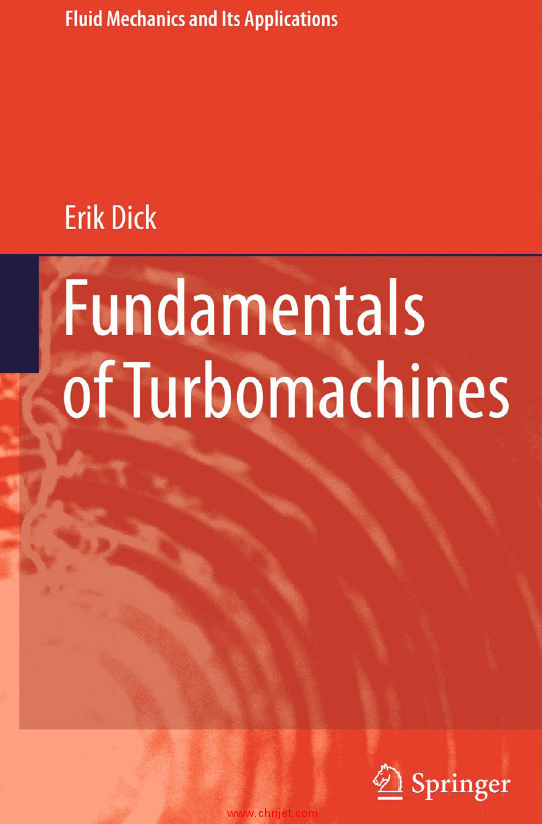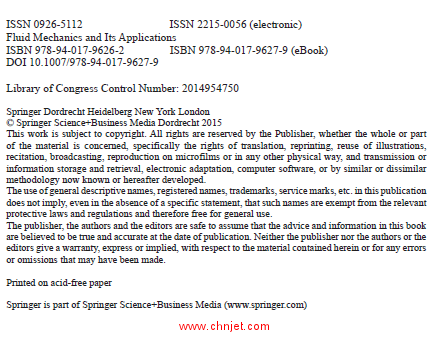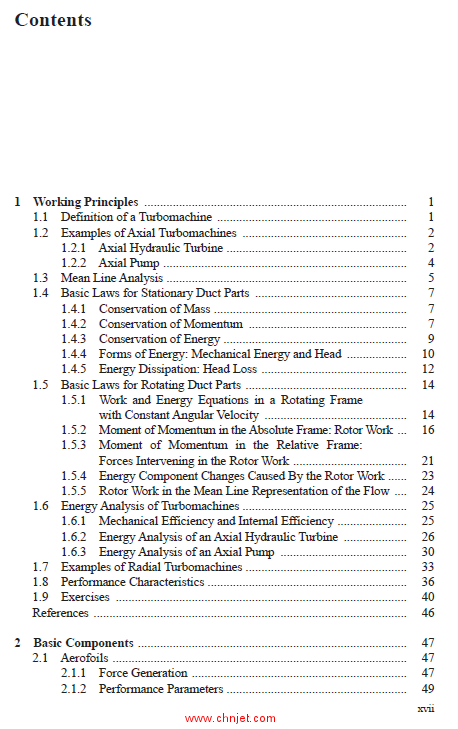马上注册,结交更多好友,享用更多功能,让你轻松玩转社区。
您需要 登录 才可以下载或查看,没有账号?立即注册


x
《Fundamentals of Turbomachines》
涡轮机原理
作者:Erik Dick
Department of Flow, Heat and Combustion
Mechanics
Ghent University
出版社:Springer
出版时间:2015年
《Fundamentals of Turbomachines》

《Fundamentals of Turbomachines》

《Fundamentals of Turbomachines》

《Fundamentals of Turbomachines》

《Fundamentals of Turbomachines》

目录
1 Working Principles 1
1.1 Definition of a Turbomachine 1
1.2 Examples of Axial Turbomachines 2
1.2.1 Axial Hydraulic Turbine 2
1.2.2 Axial Pump 4
1.3 Mean Line Analysis 5
1.4 Basic Laws for Stationary Duct Parts 7
1.4.1 Conservation of Mass 7
1.4.2 Conservation of Momentum 7
1.4.3 Conservation of Energy 9
1.4.4 Forms of Energy: Mechanical Energy and Head 10
1.4.5 Energy Dissipation: Head Loss 12
1.5 Basic Laws for Rotating Duct Parts 14
1.5.1 Work and Energy Equations in a Rotating Frame
with Constant Angular Velocity 14
1.5.2 Moment of Momentum in the Absolute Frame: Rotor Work 16
1.5.3 Moment of Momentum in the Relative Frame:
Forces Intervening in the Rotor Work 21
1.5.4 Energy Component Changes Caused By the Rotor Work 23
1.5.5 Rotor Work in the Mean Line Representation of the Flow 24
1.6 Energy Analysis of Turbomachines 25
1.6.1 Mechanical Efficiency and Internal Efficiency 25
1.6.2 Energy Analysis of an Axial Hydraulic Turbine 26
1.6.3 Energy Analysis of an Axial Pump 30
1.7 Examples of Radial Turbomachines 33
1.8 Performance Characteristics 36
1.9 Exercises 40
References 46
2 Basic Components 47
2.1 Aerofoils 47
2.1.1 Force Generation 47
2.1.2 Performance Parameters 49
xviii Contents
2.1.3 Pressure Distribution 51
2.1.4 Boundary Layer Separation 52
2.1.5 Loss Mechanism Associated to Friction: Energy Dissipation 55
2.1.6 Profile Shapes 58
2.1.7 Blade Rows with Low Solidity 59
2.2 Linear Cascades 60
2.2.1 Relation with the Real Machine 60
2.2.2 Cascade Geometry 61
2.2.3 Flow in Lossless Cascades: Force Components 62
2.2.4 Significance of Circulation 65
2.2.5 Flow in Lossless Cascades: Work 67
2.2.6 Flow in Cascades with Loss: Force Components 68
2.2.7 Flow in Cascades with Loss: Energy Dissipation
and Work by Drag Force 70
2.2.8 The Zweifel Tangential Force Coefficient 72
2.2.9 The Lieblein Diffusion Factor 74
2.2.10 Performance Parameters of Axial Cascades 75
2.3 Channels 75
2.3.1 Straight Channels 75
2.3.2 Bends 77
2.4 Diffusers 79
2.4.1 Dump Diffusers 79
2.4.2 Inlet Flow Distortion 79
2.4.3 Flow Separation 81
2.4.4 Flow Improvement 81
2.4.5 Representation of Diffuser Performance 82
2.4.6 Equivalent Opening Angle 84
2.4.7 Diffusion in a Bend 85
2.5 Exercises 87
References 95
3 Fans 97
3.1 Fan Aplications and Fan Types 97
3.1.1 Fan Applications 97
3.1.2 Large Radial Fans 98
3.1.3 Small Radial Fans 99
3.1.4 Large Axial Fans 99
3.1.5 Small Axial Fans 100
3.1.6 Cross-Flow Fans 100
3.2 Idealised Mean Line Analysis of a Radial Fan 101
3.2.1 Idealised Flow Concept: Infinite Number of Blades 101
3.2.2 Degree of Reaction 102
3.2.3 Relation Between Rotor Blade Shape and Performance
Parameters 103
3.2.4 Performance Characteristics with Idealised Flow 105
Contents xix
3.3 Radial Fan Analysis for Lossless Two-Dimensional Flow
with Finite Number of Rotor Blades 106
3.3.1 Relative Vortex in Blade Channels 106
3.3.2 Velocity Difference over a Rotating Blade 107
3.3.3 Slip: Reduction of Rotor Work 112
3.3.4 Number of Blades and Solidity: Pfleiderer Moment
Coefficient 115
3.3.5 Number of Blades: Examples 118
3.4 Internal Losses with Radial Fans 120
3.4.1 Turning Loss at Rotor Entrance 120
3.4.2 Incidence Loss at Rotor Entrance 120
3.4.3 Displacement by Blade Thickness 122
3.4.4 Rotor Friction Loss and Rotor Diffusion Loss 123
3.4.5 Dump Diffusion Loss at Volute Entrance 123
3.4.6 Incidence Loss at Volute Entrance 125
3.4.7 Friction Loss Within the Volute 126
3.4.8 Diffusion at the Rotor Inlet 126
3.4.9 Flow separation at Rotor Inlet and Rotor Outlet 127
3.4.10 Applicability of the Loss Models 129
3.4.11 Optimisation of the Rotor Inlet of a Centrifugal Fan 129
3.4.12 Characteristics Taking Losses into Account 131
3.5 Overall Performance Evaluation 134
3.5.1 Mechanical Loss 134
3.5.2 Leakage Loss 135
3.5.3 Overall Efficiency with Power Receiving Machines 135
3.5.4 Overall Efficiency with Power Delivering Machines 136
3.6 Rotor Shape Choices with Radial Fans 136
3.7 Axial and Mixed-Flow Fans 140
3.7.1 Degree of Reaction with Axial Fans 140
3.7.2 Free Vortex and Non-Free Vortex Types 141
3.7.3 Axial Fan Characteristics; Adjustable Rotor Blades 143
3.7.4 Mixed-Flow Fans 144
3.8 Exercises 146
3.8.1 Centrifugal Pump (Idealised Flow) 146
3.8.2 Rotor of a Centrifugal Fan (Finite Number of Blades
and Internal Losses) 146
3.8.3 Number of Blades of a Rotor of a Centrifugal Fan 147
3.8.4 Volute of a Centrifugal Fan 147
3.8.5 Leakage Flow Rate with Centrifugal Fan 147
3.8.6 Centrifugal Pump (Finite Number of Blades and
Internal Losses) 148
3.8.7 Axial Fan (Idealised Flow): Analysis on Average
Diameter 148
3.8.8 Axial Fan (Idealised Flow): Free Vortex and Non-
Free Vortex 149
xx Contents
3.8.9 Inlet Guide Vane with a Centrifugal Fan 149
3.8.10 Change of Rotational Speed with Centrifugal and
Axial Fans 149
3.8.11 Two-Stage Axial Fan 150
3.8.12 Axial Turbine 151
References 151
4 Compressible Fluids 153
4.1 Basic Laws 153
4.2 Compressibility and Velocity of Sound 156
4.3 Compressibility Effect on the Velocity-Pressure Relation 158
4.4 Shape of a Nozzle 160
4.5 Nozzle with Initial Velocity 162
4.6 Nozzle with Losses: Infinitesimal Efficiency 163
4.7 Isentropic and Polytropic Efficiencies 167
4.8 Exercises 171
References 174
5 Performance Measurement 175
5.1 Pressure Measurement 175
5.1.1 The Metal Manometer 175
5.1.2 The Pressure Transducer 175
5.1.3 The Digital Manometer 176
5.1.4 Calibration of Pressure Meters 177
5.2 Temperature Measurement 177
5.2.1 The Glass Thermometer 177
5.2.2 The Temperature Transducer 177
5.2.3 The Digital Thermometer 178
5.3 Flow Rate Measurement 178
5.3.1 Reservoir 178
5.3.2 Flow Over a Weir 178
5.3.3 Pressure Drop Devices 179
5.3.4 Industrial Mass Flow Rate Meters 180
5.3.5 Positioning of Flow Rate Meters in Ducts 180
5.4 Torque Measurement 181
5.4.1 Swinging Suspended Motor or Brake 181
5.4.2 Calibrated Motor 181
5.4.3 The Torque Transducer 181
5.5 Rotational Speed Measurement 182
5.5.1 Pulse Counters 182
5.5.2 The Speed Transducer 182
5.5.3 Electric Tachometer 182
5.6 Laboratory Test of a Pelton Turbine 182
5.6.1 Test Rig 182
5.6.2 Measurements 183
Contents xxi
5.6.3 Measurement Procedure 183
5.6.4 Calculations 184
5.6.5 Measurement Example 184
5.7 Laboratory Test of a Centrifugal Fan 184
5.7.1 Test Rig 184
5.7.2 Measurements 187
5.7.3 Measurement Procedure 187
5.7.4 Calculations 188
5.7.5 Measurement Example 188
5.8 Laboratory Test of a Centrifugal Pump 189
5.8.1 Test Rig 189
5.8.2 Measurements 190
5.8.3 Measurement Procedure 190
5.8.4 Calculations 191
5.8.5 Measurement Example 192
6 Steam Turbines 193
6.1 Applications of Steam Turbines 193
6.2 Working Principles of Steam Turbines 195
6.3 The Steam Cycle 199
6.4 The Single Impulse Stage or Laval Stage 200
6.4.1 Velocity Triangles 200
6.4.2 Work and Energy Relations 201
6.4.3 Stage Efficiency Definitions 204
6.4.4 Blade Profile Shape 205
6.4.5 Loss Representation 208
6.4.6 Optimisation of Total-to-Static Efficiency 209
6.5 The Pressure-Compounded Impulse Turbine
or Rateau Turbine 212
6.5.1 Principle 212
6.5.2 Efficiency 213
6.6 The Velocity-Compounded Impulse Turbine or Curtis Turbine 214
6.7 The Reaction Turbine 217
6.7.1 Degree of Reaction 217
6.7.2 Efficiency 218
6.7.3 Axial Inlet and Outlet 222
6.8 Steam Turbine Construction Forms 224
6.8.1 Large Steam Turbines for Power Stations 224
6.8.2 Industrial Steam Turbines 229
6.9 Blade Shaping 231
6.9.1 HP and IP Blades 231
6.9.2 LP Blades 233
6.10 Exercises 236
References 246
xxii Contents
7 Dynamic Similitude 247
7.1 Principles of Dynamic Similitude 247
7.1.1 Definition of Dynamic Similitude 247
7.1.2 Dimensionless Parameter Groups 248
7.1.3 Similitude Conditions 248
7.1.4 Purpose of Similitude Analysis 250
7.1.5 Dimensional Analysis 251
7.1.6 Independent and Dependent Parameter Groups 252
7.1.7 Dimensionless Parameter Groups in Turbomachines
with a Constant Density Fluid 252
7.1.8 Strong and Weak Similitude Conditions 254
7.2 Characteristic Numbers of Turbomachines 254
7.2.1 Definition of a Characteristic Number 254
7.2.2 Specific Speed and Specific Diameter 255
7.2.3 Relation Between Characteristic Numbers
and Machine Shape 257
7.2.4 Design Diagrams 259
7.2.5 Shape of Characteristic Curves 261
7.2.6 Power Specific Speed 262
7.3 Application Example of Similitude: Variable Rotational
Speed with a Pump 263
7.4 Imperfect Similitude 266
7.4.1 Effect of Reynolds Number with the Same Fluid 266
7.4.2 Effect of Relative Roughness 267
7.4.3 Effect of Viscosity 268
7.4.4 Rotor Diameter Reduction: Impeller Trimming 270
7.4.5 Reduced Scale Models 271
7.5 Series and Parallel Connection 272
7.5.1 Parallel Connection of Fans 272
7.5.2 Parallel Connection of Pumps 273
7.5.3 Series Connection of Fans 274
7.6 Turbomachine Design Example: Centrifugal Fan 276
7.7 Exercises 279
References 282
8 Pumps alic283
8.1 Cavitation 283
8.1.1 Cavitation Phenomenon and Cavitation Consequences 283
8.1.2 Types of Cavitation 284
8.1.3 Cavitation Assessment: Cavitation Number and
Required Net Positive Suction Height 286
8.1.4 Optimisation of the Inlet of a Centrifugal Pump Rotor 289
8.1.5 Net Positive Suction Head of the Installation 291
8.1.6 Increasing the Acceptable Suction Height 292
Contents xxiii
8.2 Priming of Pumps: Self-Priming Types 293
8.2.1 Side Channel Pump 293
8.2.2 Peripheral Pump (regenerative pump) 295
8.2.3 Self-Priming Centrifugal Pump 296
8.2.4 Jet Pump 297
8.3 Unstable Operation 297
8.4 Component Shaping 299
8.4.1 Simply and Doubly Curved Blades in Radial Rotors 299
8.4.2 Mixed-Flow and Axial Pumps 300
8.4.3 Pump Inlet 300
8.4.4 Pump Outlet 301
8.4.5 Vaneless Diffuser Rings 301
8.4.6 Vaned Diffuser Rings 302
8.4.7 Volute 303
8.4.8 Return Channels 305
8.5 Internal Parallel and Series Connection Of Rotors 305
8.5.1 Reason for Internal Parallel or Series Connection 305
8.5.2 Internal Parallel Connection of Rotors 306
8.5.3 Internal Series Connection of Rotors: Multistage Pumps 306
8.6 Constructional Aspects 307
8.6.1 Rotor 307
8.6.2 Stator 307
8.6.3 Shaft Sealing 307
8.6.4 Bearings 309
8.6.5 Axial Force Balancing with Single-Stage Pumps 309
8.6.6 Axial Force Balancing with Multistage Pumps 310
8.6.7 Wear Rings 311
8.7 Special Pumps 311
8.7.1 Borehole Pumps 312
8.7.2 High-Pressure Pumps 312
8.7.3 Sealless Pumps: Circulation Pumps, Chemical Pumps 312
8.7.4 Slurry Pumps 313
8.7.5 Pumping of Solid Materials 314
8.7.6 Vertical Submerged Pumps 314
8.7.7 Partial Emission Pumps 315
8.7.8 Pumps for Viscous Fluids 315
8.8 Exercises 316
8.8.1 Looking up Pump Characteristics 316
8.8.2 Verification of an NPSH-Value 316
References 317
9 Hydraulic Turbines 319
9.1 Hydraulic Energy 319
9.2 Hydraulic Turbine Types 320
9.2.1 Large Turbines (> 10 MW) 320
9.2.2 Small Turbines (< 10 MW) 322
xxiv Contents
9.3 Pelton Turbines: Impulse Turbines 324
9.3.1 Performance Characteristics 324
9.3.2 Specific Speed 326
9.3.3 Determination of the Main Dimensions 328
9.3.4 Flow Rate Control and Over-Speed Protection 328
9.4 Francis and Kaplan Turbines: Reaction Turbines 329
9.4.1 Shape of the Velocity Triangles: Kinematic Parameters 329
9.4.2 Optimisation of the Velocity Triangles 330
9.4.3 Degree of Reaction and Speed Ratio 331
9.4.4 Velocity Triangles with Varying Degree of Reaction 332
9.4.5 Specific Speed and Meridional Shape of Francis Turbines 333
9.4.6 Flow Rate Control with Reaction Turbines 335
9.4.7 Examples (Figs. 9.16, 9.17) 337
9.5 Bulb and Tube Turbines 338
9.6 Reversible Pump-Turbines 340
9.7 Exercises 342
References 345
10 Wind Turbines 347
10.1 Wind Energy 347
10.2 Types of Wind Energy Conversion Systems 348
10.2.1 Drag Machines 348
10.2.2 High-Speed Horizontal-Axis Turbines 349
10.2.3 Technical Aspects of Horizontal-Axis Wind
Turbines for Electricity Generation 351
10.2.4 Low-Speed Horizontal-Axis Wind Turbines 355
10.2.5 Vertical-Axis Wind Turbines 356
10.3 Wind Turbine Performance Analysis 358
10.3.1 Momentum Analysis (Single Streamtube Analysis) 358
10.3.2 Multiple Streamtube Analysis 361
10.3.3 Blade Element Analysis 363
10.4 Adaptation to a Wind Regime 365
References 368
11 Power Gas Turbines 369
11.1 General Concept and Components 369
11.1.1 Definition of a Gas Turbine 369
11.1.2 Comparison with Other Thermal Engines 371
11.1.3 Example of a Power Gas Turbine 372
11.1.4 Compressor Part 374
11.1.5 Turbine Part 377
11.1.6 Combustion Chamber 381
11.2 Thermodynamic Modelling 384
11.2.1 Isentropic Efficiency with Adiabatic Compression
or Expansion 384
11.2.2 Reheat Effect 387
Contents xxv
11.2.3 Infinitesimal Efficiency; Polytropic Efficiency 389
11.2.4 Thermodynamic Properties of Air and Combustion Gas 392
11.2.5 Heat Capacity Representation 396
11.2.6 Cooled Expansion 396
11.2.7 Compression with Extraction 401
11.3 Performance of Simple-Cycle Power Gas Turbines 402
11.3.1 Idealised Simple Cycle 402
11.3.2 Simple Cycle with Component Efficiencies and
Different Heat Capacities of Air and Combustion Gas 403
11.3.3 Simple Cycle with Component Efficiencies, Cooling
and Variable Gas Properties 405
11.4 Performance of Power Gas Turbines with Enhanced Cycles 409
11.4.1 Compression with Intercooling 409
11.4.2 Expansion with Reheat 411
11.4.3 Recuperator 412
11.4.4 Combined Gas and Steam Cycles 413
11.4.5 Steam Injection 416
References 417
12 Thrust Gas Turbines 419
12.1 Thrust Generation 419
12.1.1 Screw or Propeller 419
12.1.2 Reactor or Jet Engine 423
12.1.3 Rocket 426
12.2 Overview of Aircraft Gas Turbine Engines 427
12.2.1 Turbojet 427
12.2.2 Turboprop and Turbo-Shaft 427
12.2.3 Bypass Turbojet 428
12.2.4 Turbofan 428
12.2.5 Prop-fan and Unducted Fan 429
12.2.6 Geared Turbofan 432
12.3 Performance Parameters of Aircraft Propulsion Systems 432
12.3.1 Specific Thrust 432
12.3.2 Dynamic Power 433
12.3.3 Gas Power and Dynamic Efficiency 433
12.3.4 Thermal Power, Thermodynamic Efficiency and
Thermal Efficiency 433
12.3.5 Propulsive Power and Propulsive Efficiency 434
12.3.6 Overall Efficiency 434
12.3.7 Rocket 435
12.3.8 Generalisation for Double-Flow Engines 435
12.3.9 Specific Fuel Consumption 437
12.4 Performance of the Gas Generator
and the Single-Jet Engine 438
12.4.1 Analysis with Loss-Free Components 439
12.4.2 Analysis with Component Losses 441
xxvi Contents
12.5 Performance of Double-Flow Engines 444
12.5.1 Unmixed Flows (Double-Jet Engine: Turbofan,
Turboprop) 444
12.5.2 Mixed Flows (Bypass Engine) 448
12.5.3 Intercooling and Recuperation 450
12.6 Technological Aspects of the Turbofan Engine 451
12.6.1 Discs and Shafts 451
12.6.2 Vanes and Blades 451
12.6.3 Combustion Chamber 452
12.6.4 Mixer and Thrust Reverser 454
12.7 Exercises 454
12.7.1 Single-Flow Jet Engine 454
12.7.2 Single-Flow Jet Engine with Post-Combustion 455
12.7.3 Turbofan with Separate Flows 456
12.7.4 Turbofan with Mixed Flows 456
12.7.5 Optimisation of Turbine Inlet Temperature with a
Turbofan Engine 456
12.7.6 Helicopter Rotor 456
12.7.7 Ramjet 457
References 457
13 Axial Compressors 459
13.1 Mean Line Analysis 459
13.1.1 Velocity Triangles 460
13.1.2 Fundamental Equations 461
13.1.3 Loss Representation 462
13.1.4 Loss Coefficients 465
13.1.5 Force Components 465
13.1.6 Diffusion Factor and Loss Correlations 466
13.1.7 Kinematic Parameters 470
13.1.8 Secondary Flow: Principle 471
13.1.9 Radial Variation of Flow: Principle 473
13.1.10 Optimisation of a Stage 474
13.1.11 Blade Shape 476
13.1.12 Attainable Pressure Ratio 478
13.2 Secondary Flow 478
13.2.1 Definition of Secondary Flow 478
13.2.2 Passage Vortex and Trailing Vortices 479
13.2.3 Corner Vortices 480
13.2.4 Horseshoe Vortex 480
13.2.5 Leakage Vortex and Scraping Vortex 480
13.2.6 Loss Assessment 481
13.3 Radial Flow Variation 481
13.3.1 S1-S2 Decomposition 481
13.3.2 Radial Equilibrium 482
13.3.3 Free Vortex Blades 483
Contents xxvii
13.3.4 Forcing of the Vortex Distribution 485
13.3.5 Effect of End Wall Boundary Layers 487
13.3.6 Three-dimensional Blade Design 488
13.4 Compressor Blade Profiles 491
13.4.1 Subsonic and Supercritical Cascades 491
13.4.2 Transonic Cascades 494
13.4.3 Supersonic Cascades and Transonic Cascades with
High Inlet Mach Number 496
13.5 Performance Characteristics and Operating Range 497
13.5.1 General Shape of a Characteristic Curve 497
13.5.2 Rotating Stall 498
13.5.3 Choking 499
13.5.4 Surge 501
13.5.5 Operating Range 502
13.6 Exercises 505
References 506
14 Radial Compressors 509
14.1 Construction Forms and Applications 509
14.1.1 Rotor Types 509
14.1.2 General Shape of a Radial Compressor 511
14.1.3 Comparison Between Radial and Axial Compressors 512
14.1.4 Examples of Radial Compressors 513
14.2 Kinematic Parameters 516
14.3 Pressure Ratio 519
14.4 Rotor Shape 521
14.4.1 Number of Blades 521
14.4.2 Inducer 523
14.5 Diffusers 525
14.5.1 Flow Non-homogeneity at Rotor Outlet 525
14.5.2 Mixing Zone 526
14.5.3 Vaneless Diffusers 527
14.5.4 Vaned Diffusers 527
14.6 Performance Characteristics 528
14.6.1 Flow Instability 528
14.6.2 Choking 528
14.6.3 Operating Characteristics and Operating Range 529
14.7 Exercises 531
14.7.1 Velocity Variation at Constant Radius in a Rotor 531
14.7.2 Variable Geometry 533
References 533
15 Axial and Radial Turbines for Gases 535
15.1 Axial Turbines 535
15.1.1 Kinematic Parameters 535
15.1.2 Radial Variation of Flow Parameters 541
xxviii Contents
15.1.3 Blade Profiles 542
15.1.4 Three-dimensional Blade Design 545
15.1.5 Vane and Blade Clocking 546
15.1.6 Operating Characteristic of Axial Turbines 546
15.2 Radial Turbines 549
15.2.1 Shape and Functioning 549
15.2.2 Kinematic Parameters 551
15.2.3 Operating Characteristic of Radial Turbines 553
15.2.4 Radial Turbine Applications 554
15.3 Dimensional Analysis with Compressible Fluids 554
15.3.1 Independent and Dependent Π-groups 554
15.3.2 Dimensionless Compressor and Turbine Characteristics 556
15.3.3 Corrected Quantities 556
15.4 Exercises 557
References 558
Index 561
专业书籍
下载地址:(回复后可见)
| ![]()
![]()